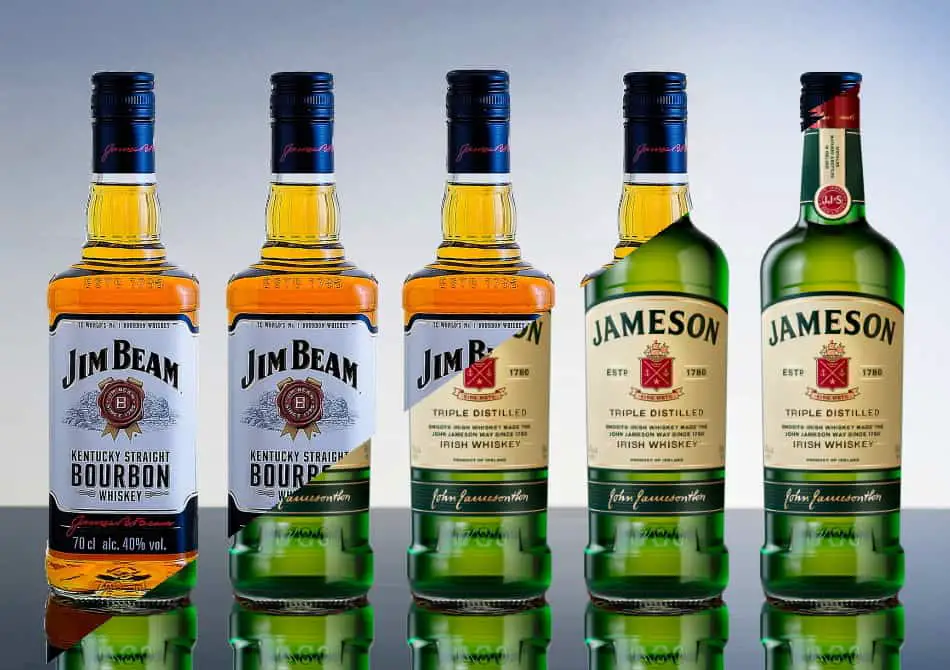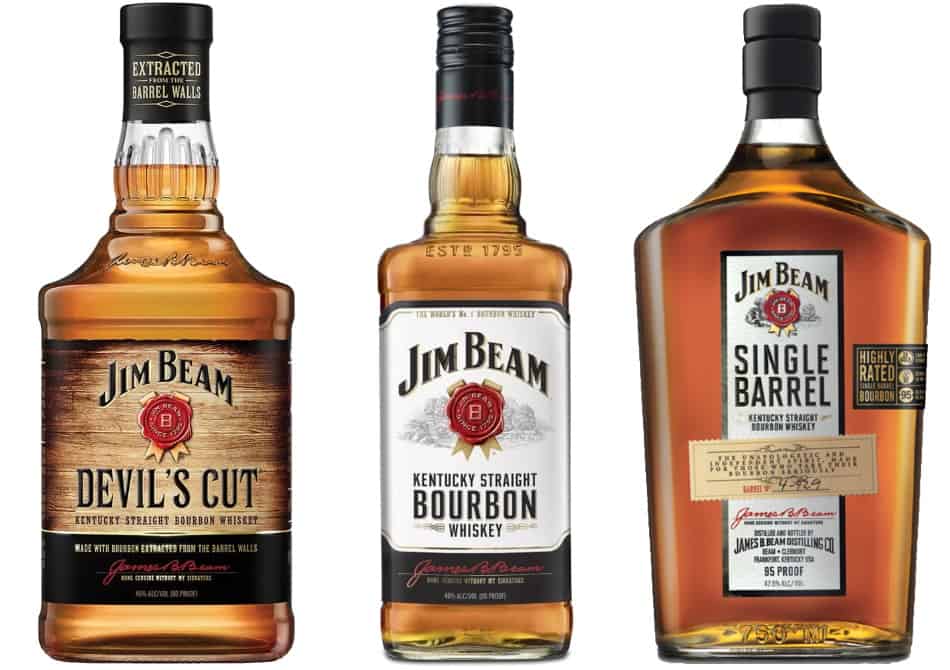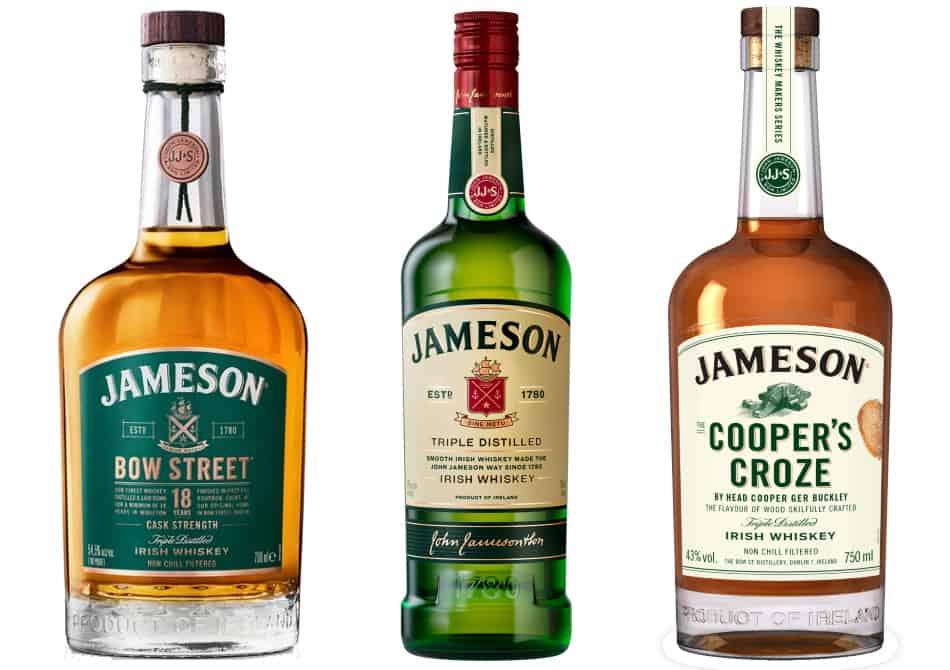Jim Beam is the second best-selling whiskey brand in the world and Jameson is the third best-selling whiskey brand in the world. But that difference is probably only important to the number one best-selling whiskey brand in the word and not to you and me. So here are 11 (more relevant) differences between Jim Beam and Jameson whiskeys.

1. Type of Whiskey – Bourbon / Irish
The first difference between Jim Beam and Jameson is that they’re different types of whiskey. Jim Beam is a bourbon whereas Jameson is an Irish whiskey.
This may seem unimportant but it’s not. Whiskey types are defined by law and many of the conditions a whiskey must meet to be defined as a particular type of whiskey have to do with how it’s made, which (and this is where it’s important) effects its flavor.
Bourbons must be:
- Made in America
- Made from at least 51% corn
- Distilled to no more than 80%ABV
- Aged in new, charred oak barrels
- Placed in the barrel at no more than 62.5%ABV
- Bottled at a minimum of 40%ABV
Irish Whiskey must be:
- Made in Ireland
- Distilled to no more than 94.8%ABV
- Matured for at least three years in wooden casks
- Bottled at a minimum of 40%ABV
2. The Grains Used to Make Them
Although, with regard to the legal definitions these are the differences between bourbon and Irish whiskey, there’s still plenty of room for many other differences between Jim Beam and Jameson whiskeys. And one of them is the grains used to make them.
Jim Beam whiskeys are made from a mash bill of corn, rye and malted barley and while the percentages of each are unknown, they must be, as mentioned above, at least 51% corn (except the rye whiskeys which are not bourbons, and by law must be at least 51% rye).
Jameson whiskeys are made from malted barley, unmalted barley, and maize (corn), and the percentages of each are also unknown.
3. Pot Still Whiskey
Jameson is a blend of pot still and grain whiskey, and Jim Beam is not.
Pot still whiskey is only made in Ireland and is whiskey made from malted and unmalted barley, that was distilled in a pot still. Since whiskey made from malted barley only and distilled in a pot still is called malt whiskey, and unmalted barley as well as other grains are usually distilled in a column still, this unusual combination of unmalted barley and pot still distillation is called pot still whiskey.
This means that Jameson is a blend of whiskey distilled in a pot still and whiskey distilled in a column still, whereas all Jim Beam whiskey is distilled in a column still.
This difference between the two is important because pot still distillation is done in batches where the taste of each run is slightly different. That means that in order for Jameson whiskeys to have a consistent taste they have to be blended from the different whiskeys of different runs, different casks and different ages until it tastes the same as previous versions.
This is not what is usually meant by a blended whiskey because we’re not talking about blending different whiskeys but different versions of the same whiskey. Although, it is that too. Which bring us nicely on to the next difference between Jim Beam and Jameson …
4. Blended Whiskey
As mentioned, Jameson is a blend of pot still and grain whiskey and Jim Beam is not.
Once again, this means that the pot still and grain whiskeys need to be blended using the best combinations and proportions of each in order to produce a whiskey that tastes the same as its previous versions.
5. Number of Distillations – Two / Three

Distillation separates the alcohol from the water so it can be concentrated but at the same time it also separates out many unpleasant tasting impurities from the grain or the by-products created by the yeast during the fermentation process.
This means that the more times a spirit is distilled the more unpleasant flavor compounds are removed and the smoother the whiskey will be. That’s why most types of whiskey including Scotch, American, and Japanese whiskeys, are distilled twice – bourbons and Jim Beam included.
Irish whiskeys on the other hand, are usually distilled three times – Jameson included. Which is why Jameson whiskeys are known for being smooth.
6. The Length of Time Spent Maturing
Although as seen above, there’s no legal minimum aging period for bourbon whereas there is for Irish whiskey (3 years), the standard expressions of both Jim Beam and Jameson are aged for at least four years.
However, when it comes to the length of time their more complex expressions are matured, there’s a big difference between the two. The more complex Jim Beam whiskeys are aged for – in their own words – ‘more’ than four years and while technically speaking that could be a lot more than four years, it’s probably not because Jim Beam would want to say if their whiskeys were aged for ‘more’ than five years.
On the other hand, the more complex Jameson whiskeys are aged for a lot longer. The expressions of the Whiskey Makers Series are aged between five to 12 years and the two 18 year old expressions are aged for … well 18 years.
7. Number And Type of Casks Used For Maturation
Jim Beam and Jameson whiskeys are matured in a different number and type of casks.
Jim Beam whiskeys are matured in new, charred, American white oak barrels. Jameson whiskeys, however, are matured in ex-bourbon and ex-sherry barrels. Which is why you find sherry and fruity flavors in Jameson whiskeys.
Jameson also has two whiskeys (the Caskmates series) that are aged in barrels that were previously used to age beer. This creates whiskeys with some stout or IPA influence. It’s a bit more complicated than that because the previously aged beer now influencing the Jameson whiskey, was itself influenced by what had been aged in the barrels before it, which was – Jameson whiskey.
8. The Different Whiskeys Within Each Brand
There are 13 current Jim Beam whiskeys and nine current Jameson whiskeys.
The following table shows the different whiskeys Jim Beam make and their unique characteristics.
| Whiskey | Unique Characteristics |
|---|---|
| White Label | Standard expression |
| Rye | Standard rye expression |
| Apple | Combination of whiskey and apple liqueur |
| Honey | Combination of whiskey and honey liqueur |
| Fire | Combination of whiskey and cinnamon liqueur |
| Red Stag | Combination of whiskey and cherry liqueur |
| Vanilla | Combination of whiskey and vanilla liqueur |
| Peach | Combination of whiskey and peach liqueur |
| Orange | Combination of whiskey and orange liqueur |
| Black Extra-Aged | Aged for longer than the standard expression |
| Devil’s Cut | Contains whiskey extracted from deep inside the barrel walls |
| Double Oak | Aged in two barrels |
| Single Barrel | Comes from the best barrels |
As you can see, Jim Beam make a standard expression, a rye expression, and seven drinks that are not technically whiskeys (due to being less than 40%ABV and containing additives) but a combination of whiskey and liqueurs of different flavors.
They also make several more complex whiskeys. Black Extra-Aged is aged for longer than usual (although as mentioned, how much longer is unknown). Devil’s Cut is a blend of Black Extra-Aged and whiskey extracted from deep inside the barrel walls.
The Double Oak is first aged in new, charred, American white oak barrels for four years and is then transferred to a second freshly charred, white oak barrel. The Single Barrel expressions come from barrels that due to various circumstantial factors such as placement in the rack house, the intensity of the season and length of aging, produce a more flavorful whiskey.

The following table shows the different whiskeys Jameson make and their unique characteristics.
| Whiskey | Unique Characteristics |
|---|---|
| Jameson Irish | Standard expression |
| Black Barrel | Aged in barrels that are charred twice |
| 18 Years | |
| Bow Street 18 Years | Bottled at cask strength |
| Caskmates Stout Edition | Aged in barrels that previously held stout beer |
| Caskmates IPA Edition | Aged in barrels that previously held IPA |
| Distiller’s Safe | |
| Cooper’s Croze | Blend of whiskeys from four different barrels |
| Blender’s Dog |
The Black Barrel is charred twice to give it more intense flavors. Charring barrels breaks down parts of the oak which creates flavor compounds for the whiskey to pick up and absorb, makes it easier for the whiskey to seep further into the wood to pick them up and creates a layer of charcoal that filters out unwanted flavors. Charring barrels twice does all that only even more.
The Caskmates whiskeys are aged in barrels that were previously used to age beer. Distiller’s Safe, Cooper’s Croze and Blender’s Dog are from Jameson’s Whiskey Makers Series, which highlights the effect different parts of the whiskey making process have on the final flavor. Cooper’s Croze highlights the effect of the barrel, which is why so many are used to make it.

9. Alcohol Content
There’s some difference between Jim Beam and Jameson in terms of the alcohol content of their whiskeys, as shown in the following table.
| Jim Beam | Jameson | ||
|---|---|---|---|
| White Label | 40% | Jameson Irish | 40% |
| Rye | 40% | Black Barrel | 40% |
| Apple | 35% | 18 Years | 40% |
| Honey | 35% | Bow Street 18 Years | 54.5% – 55.3% |
| Fire | 35% | Caskmates Stout Edition | 40% |
| Red Stag | 35% | Caskmates IPA Edition | 40% |
| Vanilla | 35% | Distiller’s Safe | 43% |
| Peach | 32.5% | Cooper’s Croze | 43% |
| Orange | 35% | Blender’s Dog | 43% |
| Black Extra-Aged | 43% | ||
| Devil’s Cut | 45% | ||
| Double Oak | 43% | ||
| Single Barrel | 47.5% – 54% |
As you can see, the standard expressions of Jim Beam and Jameson are 40%ABV and most of the more complex whiskeys of both have similar ABVs of 43% or 45%.
The real differences are the Jim Beam whiskey liqueurs which are all (with one exception) 35%ABV and the cask strength Jameson whose expressions have a range of ABVs that’s significantly higher than that of the Jim Beam Single Barrel expressions.
10. Price
There’s a big difference between Jim Beam and Jameson whiskeys when it comes to price. The following table shows the approximate price for 750ml bottles (unless otherwise indicated):
| Jim Beam | Jameson | ||
|---|---|---|---|
| White Label | $23.99 (1L) | Jameson Irish | $29.99 |
| Rye | $22.99 | Black Barrel | $40.99 |
| Apple | $17.99 | 18 Years | $156.46 |
| Honey | $23.09 (1L) | Bow Street 18 Years | $179.99 |
| Fire | $17.99 | Caskmates Stout Edition | $34.79 |
| Red Stag | $18.69 | Caskmates IPA Edition | $34.99 |
| Vanilla | $17.84 | Distiller’s Safe | $73.91 |
| Peach | $17.99 | Cooper’s Croze | $71.99 |
| Orange | $16.99 | Blender’s Dog | $70.90 |
| Black Extra-Aged | $23.73 | ||
| Devil’s Cut | $23.09 | ||
| Double Oak | $22.99 | ||
| Single Barrel | $39.19 |
As you can clearly see, Jim Beam whiskeys are cheaper than Jameson whiskeys. Much cheaper. Even a 1L bottle of the standard Jim Beam expression is cheaper than a 750ml bottle of the standard Jameson expression! And when it comes to the more complex whiskeys, Jim Beam is still the cheaper of the two.
It’s not quite an equal comparison. The whiskey liqueurs that Jim Beam produce are obviously going to be cheaper than regular / normal / real (read whichever makes you feel more comfortable) whiskeys, and the two 18 year old Jamesons are understandably significantly more expensive than whiskeys that are considerably younger.
Nevertheless, overall, it’s clear that Jim Beam whiskeys are cheaper than Jameson whiskeys.
11. Flavor
The last difference between Jim Beam and Jameson whiskeys is also the most important. After all, lots of delicious flavors is (usually) the reason why you’re drinking whiskey in the first place.
The most common flavors in Jim Beam whiskeys are:
Caramel, vanilla, corn, oak, toffee, spices and peanuts
The most common flavors in Jameson whiskeys are:
Vanilla, honey, caramel, spices, fruit, cinnamon, pepper and oak
(For more details about the flavors of each specific whiskey, see the article I wrote about what Jim Beam tastes like here, and the article I wrote about what Jameson tastes like here.)
As you can see both brands have quite a few flavors in common. This is not surprising when you consider that despite their differences, Jim Beam and Jameson also have many similarities, especially when it comes to things that affect flavor. They’re both:
- Made from (partially) corn and malted barley
- Aged for at least four years
- Aged in new, charred, American white oak barrels (Jim Beam) or ex-bourbon barrels that are essentially old, charred, American white oak barrels (Jameson)
However, there is one important difference between the two brands when it comes to flavor. Jim Beam has a relatively prominent peanut flavor and Jameson has a more overall fruitiness and some sherry sweetness. If you prefer one profile over the other or dislike one of them in particular, then for you, this will be the only difference between Jim Beam and Jameson whiskeys that matters.
You can buy any of these whiskeys at drizly.com here .
.
